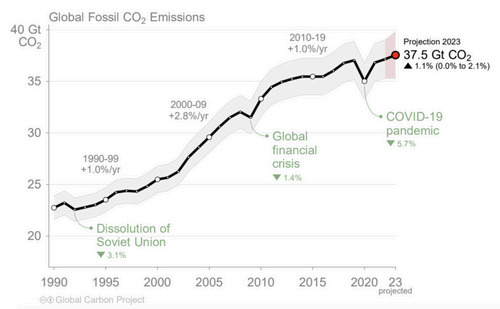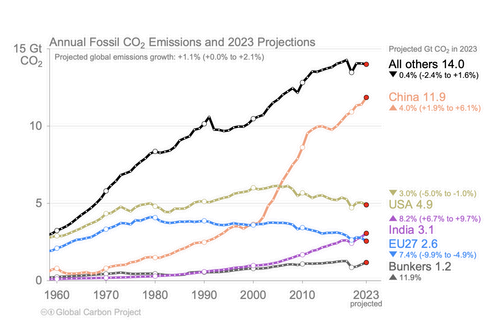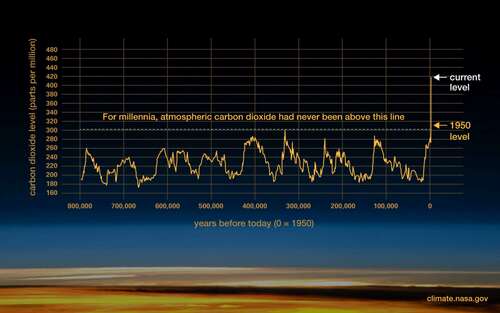Global carbon emissions are projected to go up in 2023 and are significantly higher than when nations signed the historic Paris Agreement, according to a newly released climate report.
Each year, researchers at the Center for International Climate and Environmental Research (CICERO) in Oslo, Norway painstakingly reckon how much heat-trapping carbon dioxide countries release into Earth’s atmosphere in their Global Carbon Budget Report. The projected growth rate for this year, 1.1 percent, is higher than the average growth rate of 0.5 percent per year over the past 10 years. Carbon emissions are also six percent higher than when the Paris Agreement was negotiated in 2015, making it even more challenging to reach the ambitious temperature goals set out in the pact.
In 2023, CO2 emissions from fossil fuels reached record levels, the researchers said.
“The continued growth of global emissions shows clearly that it is more urgent than ever to act if we want to have the possibility to reach the Paris Agreement’s goal of limiting global warming to well below two degrees,” CICERO director Kristin Halvorsen said in a statement.
In total, some 37.5 gigatons, or 37.5 billion tonnes, of CO2 were emitted into Earth‘s atmosphere in 2023.
(Importantly, scientists highlight that we are not doomed: We still have the ability to slash emissions and avoid the worst impacts of a warming globe.)

Estimated carbon emissions, in gigatons, emitted in 2023. It’s a 1.1 percent rise over 2022.
Credit: Global Carbon Project
Though carbon emissions decreased three percent in the United States in 2023, they went up in other countries, including India, which produced 8.2 percent more emissions, and China, where emissions increased four percent (though China’s emissions have been dramatically higher than India’s since the early 2000s and still are). China and India also drove carbon emissions from coal use to a record high.
CO2 emissions from oil use are also expected to grow 1.5 percent, mostly from aviation and ground transportation emissions in China, though these emissions are still below their pre-pandemic levels. Meanwhile, natural gas emissions might enhance very slightly, around 0.5 percent, but also might stay the same or even decrease. Though there is increased natural gas use in China, it has decreased in the European Union because of the Russian invasion of Ukraine and subsequent warring.
“…we have failed to put sufficient controls on the growth of fossil fuels and therefore CO2 emissions just keep rising.”
While there have been significant increases in renewable energy use, including in China, they haven’t kept up with increasing carbon emissions.
“China has seen continued strong growth in wind and solar power, without which emissions growth would have been much higher,” Jan Ivar Korsbakken, a senior researcher at CICERO, who makes the projections for Chinese emissions, said in a statement. “But solar and wind couldn’t face high electricity demand growth and low hydropower production due to drought, so coal power generation also grew.”
“We continually see record growth in clean energy, but we have failed to put sufficient controls on the growth of fossil fuels and therefore CO2 emissions just keep rising,” Glen Peters, also a senior researcher at CICERO, said in a statement.

The globe’s major emitters of carbon dixiode.
Credit: Global Carbon Project

Atmospheric carbon dioxide levels have skyrocketed over the past century.
Credit: NASA
The enhance marks the twelfth straight year that the average amount of CO2 in Earth’s atmosphere has increased by more than two parts per million (ppm). Atmospheric CO2 levels are now the highest they’ve been in millions of years.
With increasing emissions, the world is not on track to face the climate goals set out in the Paris Agreement, namely keeping Earth below 1.5 to 2 degrees Celsius (2.7 to 3.6 degrees Fahrenheit) of warming above pre-industrial levels, with the goal of staving off the most catastrophic impacts of climate change – extreme rain, droughts, and ice sheets melting, for instance. For the global temperature to stop rising, emissions need to drop to zero.
Want more science and tech news delivered straight to your inbox? Sign up for Mashable’s Light Speed newsletter today.
Earth’s temperature has already increased by just over 1 C, or 2 F, since the 1800s, according to the National Oceanic and Atmospheric Administration. The more carbon we release into our atmosphere, the more Earth’s average temperature will continue to rise. And the past nine years have been the warmest on record, at least since modern record-keeping began in 1880, according to NASA.
“Net zero has become the common catch phrase for doing something on climate, but at its core is the necessity to reduce CO2 emissions to near zero,” said Peters. “If countries and companies are not radically reducing CO2 emissions, then they are in no way consistent with the scientific concept of net zero emissions.”

